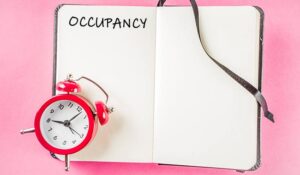In contact centres, staffing efficiency is key. But there’s a line you shouldn’t cross, and it’s called maximum occupancy.
In this instalment of our video series on the key concepts behind accurate forecasting, Call Centre Helper’s Jonty Pearce explains why exceeding 85% occupancy can do more harm than good – and how to avoid it in your calculations.
Video: Forecasting Fundamentals: Don’t Exceed 85% Maximum Occupancy
Watch the video below to hear Jonty explain what you need to know about forecasting – focusing on why you shouldn’t exceed 85% maximum occupancy:
What Is Occupancy?
Occupancy is the percentage of time that an agent is actively handling contacts during their available working time.
“One of the things you need to be really careful of when you’re doing staffing calculations is maximum occupancy.
That is the percentage of an hour that someone is actually working on contact centre calls during that period, and you shouldn’t exceed 85% of that figure.”
So, if someone is busy on calls for 51 minutes in an hour, their occupancy is 85%. That’s the recommended maximum.
Why 85% Is the Ceiling
It’s tempting to run contact centres at 90% or even 95% occupancy, especially in high-pressure or outsourced environments. But here’s the catch – it doesn’t work, as Jonty explains:
“I’ve heard a lot of outsourcers say we can take occupancy well over 90 / 95%. Yes, and I’ve looked at the figures. What actually happens here is the occupancy is actually much worse than that 95% they first think.
What happens is people get burnt out, they get to the point they can’t think straight, so effectively average handling time increases, what you find is time on hold increases, and after-call work also increases.
So, if you go over 85%, what you’ll find is that actually your average handling time goes up to cover that extra amount of occupancy.”
Once occupancy goes over 85% for any sustained period, agents start to burn out, and they lose focus, they get mentally fatigued, and the quality of their work suffers.
This leads to:
- Longer average handling times
- Increased time on hold
- More after-call work
- Lower customer satisfaction
So even though it looks like you’re squeezing more out of your team, the reality is you’re getting less.
The Numbers Behind the Rule
Let’s say you’re using a staffing calculator like the one from Call Centre Helper.
“When you’re doing a calculation, for instance, if you use the Call Centre Helper Erlang calculator, then what you’ll see is two figures.
So, for instance if you didn’t factor in occupancy, you could meet an 80% service level, for say 208 agents, but by the time you factor in 85% occupancy, that actually says you need 236 agents, and that’s before you apply shrinkage to actually meet that service level.
And if you apply something like 35% shrinkage, you’ll need 337 people on the phones or in the contact centre.”
It might tell you that to meet an 80% service level, you need 208 agents, assuming unlimited occupancy, but once you apply the 85% cap, you’ll actually need 236 agents.
And that’s before you apply shrinkage, which typically accounts for holidays, sickness, training, and other non-productive time. With 35% shrinkage, that number jumps to 337 people.
Don’t Trust the First Number
It’s easy to grab the first figure that a calculator gives you and assume it’s enough.
“So be very careful of picking the first number that comes out of an Erlang calculator”
But unless you’ve factored in a sensible occupancy limit, and applied shrinkage, you’re going to be understaffed.
And when that happens, performance drops, stress rises, and your contact centre runs into serious trouble.
Why It Matters
High occupancy looks efficient on paper. But in practice, it leads to burnout and inefficiency.
Stick to 85% as your ceiling, build your staffing plans around it, and make sure you’re looking beyond the raw numbers to what actually works in the real world.
If you are looking for more great insights from Jonty, check out these next:
- Why You Need to Check Your Forecasting Tools
- Why You Need to Account for AHT Variation Across the Day
- How to Get a 70% Forecast Accuracy With No Skill
- What’s Really Skewing Your Forecasting
Author: Jonty Pearce
Reviewed by: Robyn Coppell
Published On: 13th Oct 2025 - Last modified: 7th Nov 2025
Read more about - Video, Forecasting, Occupancy, Videos















